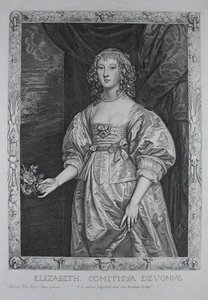| Method | Copper engraving |
| Artist | Pierre Lombart after Anthony van Dyck |
| Published | P Lombart Sculpsit et ex. Londini avec Privileige du Roy [c.1662, but c.1821 impression] |
| Dimensions | Image 316 x 235 mm, Plate 350 x 246 mm, Sheet 450 x 287 mm |
| Notes |
Three-quarter length portrait of Elizabeth Cecil, shown standing, slightly turned to the left, and facing forward. She wears a silk dress which is laced up at the front, and a pearl necklace. In her right hand, she holds a bunch of flowers. The portrait is set within an ornate frame. The portrait is based on van Dyck's painting, which is now kept at Petworth House, and was included in Pierre Lombart's most famous work, often called The Countesses. The series contained twelve portraits after Anthony van Dyck, each of which depicted the sitter in three-quarter length. The ten women and two men illustrated in the series were; Anne Carr, Countess of Bedford; Lucy, Countess of Carlisle; Margaret, Countess of Carlisle; Anna Sophia, Countess of Carnarvo; Elizabeth, Countess of Castlehaven; Elizabeth, Countess of Devonshire; Rachel, Countess of Middlesex; Penelope, Lady Herbert; Dorothy Sidney; Countess of Sunderland; Elizabeth, Countess of Morton; Henry Howard, Earl of Arundel; and Philip Herbert, Earl of Pembroke. Elizabeth Cecil, Countess of Devonshire (1619 - 1689) was the second daughter of William Cecil, 2nd Earl of Salisbury, and the wife of William Cavendish, 3rd Earl of Devonshire. Anthony van Dyck (1599-1641) was one of the most prominent Flemish Baroque painters. Born in Antwerp, he was a pupil of Hendrik van Balen, but was soon noticed by Rubens with whom he would work closely during his early career. Van Dyck became a master of the St Luke Guild in 1618, went on to paint in Italy from 1621-1626, and then worked predominantly in England from 1632 onwards, where he was knighted by Charles I. Van Dyck was very prolific, he produced many portraits for members of the European aristocracy, as well as religious and mythological paintings and works on paper. Pierre Lombart (1612/13 - 1681) was a French born engraver, working in both France and England. Although being a well recognised engraver in England, relatively little is known about his life. The first trace of Lombart in England is around 1649, and he went on to engrave numerous plates for Ogilby's various publications. Lombart's time in London can roughly be traced through his plates, which were usually inscribed with 'a Londres', and are dated until 1660. By 1663, he had returned to Paris, where he remained for the remainder of his life. O'Donoghue 1, New Hollstein (Dutch & Flemish) 256.II (Van Dyck) Condition: Slight folding and creasing to edges of the sheet, not affecting image. Whatman watermark 1821. |
| Framing | unmounted |
| Price | £60.00 |
| Stock ID | 46897 |

